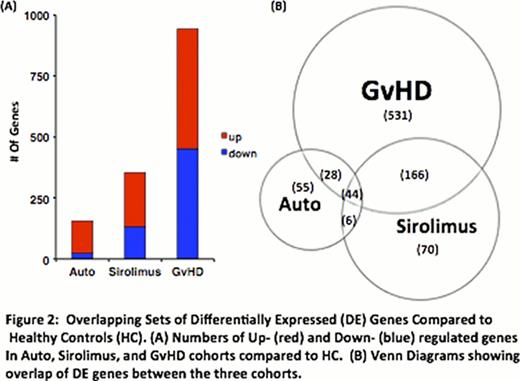Abstract
Abstract 1888
There is a critical unmet need to devise effective strategies to prevent GvHD. However, the best combinatorial therapies remain undetermined, and the identification of new targeted approaches to GvHD prevention remains a challenge. To address this, we have developed a genome-wide approach to studying GvHD, using whole-transcriptome analysis of pathogenic T cells in a clinically-relevant non-human primate (NHP) model. Using computational approaches, we have identified, for the first time, the transcriptional networks that drive primate GvHD, and that lead to its partial control with sirolimus.
CD3+/CD20- T cells were purified flow cytometrically from 4 cohorts: (1) Healthy Controls (“HC” n = 15); (2) Recipients of an autologous HSCT (“Auto” n = 3); (3) Haplo-identical allogeneic HSCT recipients without GvHD prophylaxis, who developed histopathologically confirmed severe aGvHD (“GvHD” n = 4); and (4) Allo-HSCT recipients who received sirolimus alone, and were partially protected from aGvHD (“Sirolimus” n = 4). Purification of T cells after allo-HSCT occurred 1–2 weeks post-transplant. RNA was purified (Qiagen), and rhesus macaque-specific Affymetrix Gene Arrays were performed.
Gene array signals were processed and normalized using the Robust Multichip Averaging Method and ComBat. Principal Component Analysis (PCA) was applied to summarize modes of gene array variance. Importantly, PCA revealed that variation was primarily determined by the experimental cohort (Figure 1). This result was critical, and confirmed that transcriptomics could be applied to identify genes and pathways controlling GvHD.
Differentially expressed genes (“DE”, fold change > 2) were defined between cohorts, yielding unique and overlapping gene signatures. We found that 775 annotated genes were DE between GvHD and HC and 286 were DE between Sirolimus and HC (Figure 2A, B). Importantly, a subset of the GvHD and Sirolimus DE gene sets were overlapping, indicating incomplete control of T cell activation with sirolimus (Figure 2B), and identifying pathways that could be targeted in combination with sirolimus for improved GvHD control. To further define genes by their individual expression profiles using an unbiased approach, we applied Class Neighbor Analysis (GenePattern, Figure 3A). Finally, using Ingenuity Pathway Analysis (IPA) we characterized gene signatures according to molecular pathways (using right-tailed Fisher's Exact test and FDR correction, Figure 3B).
T cells from animals with severe aGvHD demonstrated transcriptional signs of rampant proliferation and cytotoxicity as well as potentially counter-regulatory cell death pathways. IPA identified highly statistically significant upregulation of Cell Cycle and Cellular Movement networks (Figure 3B, p< 0.001) as well as Cell Trafficking and Inflammatory Response Networks (Figure 3B, p < 0.001). These networks contained some expected genes and some surprises. Thus, as previously documented, GvHD was associated with upregulation of JAK and IFN signaling (p < 0.001). Unexpectedly, GvHD was also associated with upregulation of the Sonic Hedgehog and Aurora Kinase A Pathways (p < 0.01). Both of these represent targetable pathways for which novel therapeutics are currently available.
Sirolimus resulted in significantly different gene expression patterns compared to uncontrolled GvHD. This included partial downregulation of the proliferation marker Ki-67 and the cytotoxicity gene, Granzyme B. However, there were many genes, pathways and networks that were shared between the Sirolimus and GvHD cohorts. These prominently included upregulation of the FOXM1 and IRF8 transcription factors, involved in cell cycle progression (p <0.01) and interferon signaling and effector cell differentiation (p< 0.01), respectively. Both GvHD and Sirolimus cohorts also demonstrated upregulation of the CD28, CCR5, IL-12 and IL-17 pathways (p <0.05). All of these pathways are targets of FDA-approved therapeutics (CTLA4-Ig, maraviroc, ustekinumab) amenable for clinical trials in combination with sirolimus.
This is the first description of the primate GvHD transcriptome. This network approach has identified previously unappreciated genes and pathways associated with GvHD, for which several novel therapeutic strategies are immediately available for pre-clinical and clinical evaluation.
No relevant conflicts of interest to declare.
Author notes
Asterisk with author names denotes non-ASH members.




This feature is available to Subscribers Only
Sign In or Create an Account Close Modal